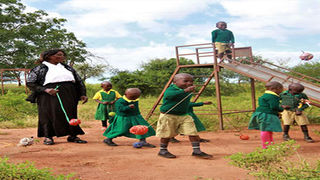
Ms Susan Muia teaches her pupils at Kalii Primary School in Makueni County constructive games, on January 7, 2020.
| FileEducation
Premium
Nursery school teacher shortage getting worse
The number of teachers for early childhood continues to decrease in the country, increasing the pupil-teacher ratio further.
This is despite the efforts being made by counties to improve the sector by ensuring more children join Early Childhood Development and Education (ECDE) centres, and recruiting teachers to the schools.
According to a Ministry of Education policy brief report, the “Status of Early Childhood Development in the 47 Counties” dated May and released yesterday, recent available data shows that the number of teachers in the ECDEs have reduced by 22,472 between 2014 and 2019.
The data shows that in 2014, there were 114,831 ECDE teacher but the number reduced to 92,359 by the end of 2019.
“This may indicate high attrition rates among ECDE teachers in the country,” reads the report.
The child-teacher ratio also remains a big challenge across all counties. The report shows that the ratio has been increasing over the years, from a national average of 25:1 in 2014 to 29:1 and 30:1 in 2016 and 2019, respectively.
Although the challenge is replicated across all the county, Turkana County has the highest child to teacher ratio -- 161: 1, signifying congestion in classrooms.
The report shows although the number of ECDE centre class sizes increased from 40,211 in 2014 to 46,530 in 2019, the average class size of an ECDE centre in Kenya remains unacceptably large at 59 in 2019, from 75 in 2014.
Kakamega County class size increased by 299 percent from 83 in 2014 to 248 in 2019.
In Kenya, about 7.2 million of the total population is made up of children below five years.
The report shows that Nairobi and Kiambu lead with the highest number of children, with 614,901 and 327,181 children, respectively.
However, an analysis of the proportion of under-fives to overall county population revealed that the under-five population as a percentage of the total population is highest in West Pokot and Mandera counties at 22 percent each, but lowest in Kirinyaga (11 percent), Embu (12 percent), Nyeri (12 percent), Tharaka Nithi (12 percent) and Makueni (12 percent).
The report further shows that child abuse and neglect also remains a great challenge across the country.
The neglect and abuse are rampant, especially in Nairobi, Kilifi, Nyandurua, Taita Taveta, Uasin Gishu, Kericho and Elgeyo Marakwet.
This is despite the government implementing the Children’s Act 2001 to protect young ones.
“Despite these efforts, many children are still being exposed to abuse and neglect,” reads the report.
Kenya has also implemented various social protection programmes that target children from vulnerable households.
Further, the report shows that child mortality rates are alarming in Western counties such as Bungoma, Busia, Kakamega, Kisumu, Siaya, Migori and Homa Bay, as well as Asal counties of Wajir, Mandera and Garissa.
The report shows that expectant mothers in Narok and West Pokot have challenges in accessing the required four antenatal visits.
Most counties have also not been able to reach the required immunisation target of 80 percent.
“Data indicates that while vaccination coverage in Nairobi and Uasin Gishu counties ranges between 94 and 98 percent, coverage is extremely low in Turkana (30 percent), Mandera (32 percent) and Wajir (38 percent),” said the report.
Children are also being exposed to diseases such as diarrhea, which is a leading cause of death for children under five years, due to low access to clean water.





